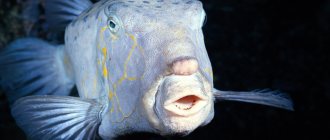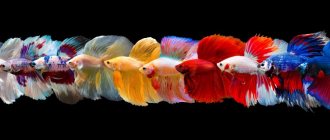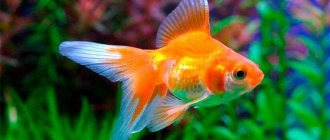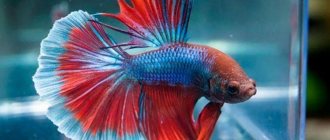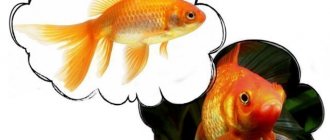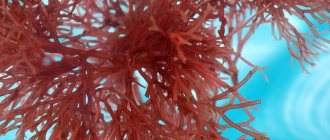Published by Nastya Titova on Thu, 28/11/2013 — 14:43
Matisse's canvases are the embodiment of meditation and visual relaxation. One of his favorite themes is an aquarium and goldfish. In Matisse's language, they are sources of absolute inner silence, contemplative detachment.
The motifs of the aquarium with goldfish are inspired by Matisse’s travels in Morocco in 1912-1913.
The most significant painting of the Moroccan period is “The Arab Coffee House”.
An ordinary and at the same time exotic plot. Two people meditate in front of a glass aquarium with goldfish. It was based on the artist’s observations, fascinated by the Arabs’ ability to stare at a flower or red fish for hours. Fish and people have a single, ocher-orange hue. Matisse wanted the viewer to experience the same meditative, contemplative relaxation through the painting.
"Arabic coffee house, 1913"
Interestingly, the picture originally looked different. All characters had their faces drawn. Then Matisse painted them over. And when a critic who observed the work process asked why he did this, Matisse replied: “To improve means to simplify.”
The great Russian art collector Sergei Ivanovich Shchukin, who discovered Matisse in Russia and actively bought his works, “did not understand” the new masterpiece. Then the artist offered the canvas to another outstanding collector, manufacturer I.A. Morozov.
But Shchukin could not allow the painting to end up in a competitor’s collection; moreover, he loved to surprise the public and was always guided by the principle: “If you experience a psychological shock when you see a painting, buy it.”
So, in April 1913, the “Arab Coffee House” won a place of honor in Shchukin’s home gallery.
Matisse's paintings amaze with their simplicity and lightness. There is a feeling that they were drawn by a conscious child. Matisse’s teacher, Gustave Moreau, reproached his student: “You won’t bring painting to this, will you?” Simplify it so much! Then painting will cease to exist..."
Henri Matisse in his apartment in Nice, 1934
Indeed, Matisse deliberately “simplified” his painting: “Today’s space is oversaturated with food for the eyes - and we often do not have time to taste it,” he said.
The artist refused to mix colors, small details and halftones - so as not to drown out the fresh sound of the paint.
He turned every figure - a woman or a fish - almost into a sign, trying to express the very essence of an action or state.
Another famous painting by Matisse, painted in Morocco, in which a container with fish appears is “Zora on the Terrace.” Young Zora is kneeling, with a glass of goldfish in front of her on the left. There is a feeling of bliss and peace in the atmosphere of the picture. The real and the fantastic merge into one. This is probably why the “grandmother” shoes set aside look so much like fish swimming in an aquarium.
"Zora on the Terrace, 1912"
Matisse created a whole series of paintings with aquariums in the spring-summer of 1912. The French poet Guillaume Apollinaire noted that at that time there were many “cyprinids” in the painting salons. Perhaps it was a tribute to fashion - an obsession with Eastern culture after numerous Chinese exhibitions.
"Goldfish and Sculpture", 1911
“Red fish in the interior”, 1912
"Red Fishes", 1911
Red Fishes are one of Matisse's most popular paintings. On it he depicts a fragment of a greenhouse, in the middle of which there is a round table with fish in an aquarium. The basis of the composition and the color focus of the painting are bright red fish circling in an aquarium.
Matisse deliberately left a white canvas around them to enhance the expressiveness of the red. The green leaves of the plants serve as a contrast to the red fish.
Pink and black shades enhance the sonority of green, and the pink halo around the aquarium gives the entire color scheme a special transparency.
The series of aquarium paintings continues in 1914 and 1915 with two works.
"Interior, aquarium with red fish", 1914
In this composition, Matisse is primarily interested in the effect of light from a window in the clear water of an aquarium. This is how the master combines his two favorite motifs - an aquarium with red fish and a window.
“Red fish palette”, 1914-1915
In October 1914, Matisse shared in a letter about his new work: “I am painting a picture, these are the same goldfish, but I am remaking them by adding a character with a palette in his hand.”
The work is very close to the previous one, but at the same time, very different from it.
The same cylindrical aquarium, the interlacing of the balcony lattice, but the planes that formed the interior space overlapped each other, as in an appliqué.
"Bowl with Goldfish", 1921-22
Letter from Henri Matisse to his wife Amelie, written at Café Monnot, Nice, November 29, 1921
In the 1940s, Matisse's health deteriorated. Confined to a wheelchair, the artist continued to create and turned to decoupage technique.
Matisse working on appliques in his studio in Nice, 1952
Matisse painted gouache paper, cut out images of algae, flowers, fish and composed large-format canvases. These works of the author are the shortest and therefore considered the most valuable.
Polynesia, sea, 1946
One of Matisse’s last outstanding works was “Chinese Fish,” created by the author in 1951. Matisse said that one of those fish is a dugong: “Here is a dugong and on top is a sea animal in the form of algae. And there are begonia flowers all around.”
- "Chinese fish", 1951
Henri Matisse achieved emotions through simple means, radically changing his vision of the world. Before him, artists sought to convey volume, but Matisse translated the whole world into a flat drawing.
In the author’s article “You need to look at the world through the eyes of a child,” Matisse wrote: “I believe that for an artist there is nothing more difficult than painting a rose; but he can create his own rose only by forgetting about all the roses painted before him... The first step to creativity is to see the true appearance of each object... To create means to express what is in you.”
"Woman in front of an aquarium", 1921-1923.
"Woman in front of an aquarium." Photo version by Paul Horst for Vogue magazine, 1952.
Source: https://glassbox-history.com/content/anri-matisse-akvariumopisets-1911
What are the features of Henri Matisse’s painting “Red Fishes”
x
Check Also
Beginning aquarists, without the necessary experience, often make the mistake of overfeeding the fish. Such zeal entails a number of unpleasant consequences. Overfeeding does not always directly cause problems in fish, but it always worsens...
Dear colleagues! Very often you can hear such banal things from the lips of beginning aquarists, when aquarium plants are called algae. Even with some experience in aquarium keeping, not every underwater aficionado...
Hello, dear readers! I am glad to welcome you again to the pages of my blog. Today I would like to touch on the topic of starting an aquarium. Despite the fact that I already have a similar article...
An aquarium in its traditional form seems like a simple design until you calculate the force that will press on the glass. However, anyone can make an aquarium with their own hands. ...
Luxury, Peace and Pleasure (1904)
This painting is a vivid illustration of how the artist searched for his “I” in the world of painting. Pointillism, the beginnings of Fauvism, and new technical techniques allowed Matisse to create a very touching and tender canvas depicting the seashore and bathers.
The painting is made with dots, but this is not pointillism. Contrasting dots are spaced far apart and placed on a bright, colorful base. The public greeted the painting friendly, and it was immediately bought by the collector Signac.
3
Essay on the painting Red Fishes by Henri Matisse
The painting “Red Fishes” is at the junction of two stylistic movements - impressionism and fauvism. Moreover, if we equate the canvas with the first, then it is rather Gauguin’s impressionism, and if we attribute “Fish” to the second movement, then rather this work is only the forerunner of the main artistic movement, the brightest representative of which was Henri Matisse.
The culminating compositional center, just like the light one, are the fish, organized in a circular motion. Four cute fish, the reflection of which we see from above the transparent water surface, contrast sharply with the greenery that surrounds the aquarium in abundance - the author placed it on a small round table, which echoes the circulation of fish.
The use of bright pure colors, the rejection of halftones and chiaroscuro creates the illusion of a pure gaze - only a child can look at the world so directly and joyfully. The picture refuses to tell anything, but only to evoke bright emotions, and it copes with this task quite well.
An almost realistic, bright picture, it is distinguished by an unconventional attitude to perspective - the viewer sees the aquarium itself with delicious fish from the side, while the table is shown from above, and it is an almost perfect circle. However, Matisse balances this illogicality by presenting the thin table leg to us from the side, thus achieving harmony and harmony in the overall composition.
Symbolists would see one consistent leitmotif in this work - the circle. A round table, a round base of the aquarium, the round leaves of most of the greenery around, the round eyes of the fish and even their round open mouths, and all this is framed by a round park fence with smooth, strongly elongated oval patterns. And besides, the fish swim in circles!
It’s difficult to say what the author meant by this, however, the whole work turned out to be somehow clean, bright, incredibly pleasant and harmonious. This is that delightful simplicity and transparency from which it is impossible to take your eyes off.
Today you can marvel at this incomparable work in Moscow at the Pushkin Museum, thanks to the first and only private owner - philanthropist S.I. Shchukin, with whom Matisse had a warm friendship. In 1912, Shchukin bought “Fish” from the author and brought it to Russia.
Essay based on the painting Red Fishes by Henri Matisse “Portrait of an Old Man in Red by Rembrandt Harmens Van Rijn Wayfarers by Pavel Nikonov”
Source: https://kartiny.rus-lit.com/matiss-anri/krasnye-rybki-anri-matiss/
Reading Woman (1895)
One of the artist’s first works, executed in a form familiar to the viewer, is “Woman Reading.”
This painting tells the story of Matisse's early development as an artist. On the right side of the picture is a woman reading a book. She sits on a chair, with her back to the viewer. The composition is balanced by a cabinet in the corner of the room and a green lamp hanging from the ceiling. The picture is filled with calm and comfort.
2
Henri Matisse
Henri Matisse (1869–1954), an outstanding French artist. Born December 31, 1869 in Le Cateau in northern France. In 1892 he came to Paris, where he studied at the Julian Academy, and later with Gustave Moreau.
The search for a direct transfer of sensations with the help of intense color, simplified drawing and flat images was reflected in the works he presented at the exhibition of the “wild” (Fauve) at the Autumn Salon of 1905.
He exhibits a number of works. These works, which created a scandalous sensation, marked the beginning of Fauvism.
At this time, Matisse discovered the sculpture of the peoples of Africa, began collecting it, and became interested in classical Japanese woodcuts and Arab decorative art.
By 1906 he completed work on the composition “The Joy of Life,” the plot of which was inspired by the poem “The Afternoon of a Faun” by S. Mallarmé: the plot combines pastoral and bacchanalia motifs. The first lithographs, woodcuts, and ceramics appeared.
Matisse's graphics combine arabesque with a subtle rendering of the sensual charm of nature.
In 1907, Matisse travels through Italy (Venice, Padua, Florence, Siena). In “Notes of a Painter” (1908), he formulates his artistic principles and speaks of the need for “emotions through simple means.” Students from different countries appear in Henri Matisse’s workshop.”Self-Portrait” 1918, Matisse Museum, Le Cate-Cambrai, France
In 1908, S.I. Shchukin ordered the artist three decorative panels for his own house in Moscow. The panel “Dance” (1910, Hermitage) presents an ecstatic dance inspired by impressions of S. Diaghilev’s Russian seasons, Isadora Duncan’s performances and Greek vase painting. In Music, Matisse presents isolated figures singing and playing various instruments.
The third panel - “Bathing, or Meditation” - remains only in sketches. Exhibited at the Paris Salon before sending them to Russia, Matisse's compositions caused a scandal with the shocking nudity of the characters and the unexpectedness of the interpretation of the images.
In connection with the installation of the panel, Matisse visited Moscow, gave several interviews for newspapers and expressed his admiration for ancient Russian painting. In the painting “Red Fishes” (1911, Museum of Fine Arts, Moscow), using the techniques of elliptical and reverse perspectives, a roll call of tones and the contrast of green and red, Matisse creates the effect of fish circling in a glass vessel.
Woman with a Hat (1905)
The years 1905–1906 saw the peak of Matisse’s creativity in the style of Fauvism. A bold combination of bright colors in those days was perceived as ugliness and something awkward. The painting “Woman in a Hat” caused a particularly negative reaction among the public. It was called “savagery”, in French fauve, from which the name of the movement came - Fauvism.
If we remember how the public received the first impressionists, the reaction to Fauvism was expected. The public was indignant, and the artists found a new, fresh stream in this direction.
“Woman in a Hat” is an extraordinary, according to the editors of most-beautyt.ru, female portrait. Against a green background, a green asymmetrical female face looks half-turned at the audience - an absolutely non-human appearance. But the artist saw the image in his own way and depicted it without observing the rules and canons.
4
Snail (1953)
Looking like a children's appliqué, "Snail" may seem like anything to an uninformed viewer. The name given by the artist suggests in which direction one should think. In fact, there is no snail. This abstract image is intended to convey the essence of the subject, rather than an exact representation of it.
Rectangular figures cut out of colored painted paper are pasted onto the base background in such a way that the impression of movement in a spiral is created. This painting is mesmerizing; you can look at it for hours from different angles. The most important thing is that it makes a person think and not hide his emotions.
Blue Nude I and Blue Nude II (1952)
At the end of his life, Matisse became interested in various techniques. He was attracted to collage, appliqué and decoupage. He took sheets of paper, painted them with gouache in various colors, and then cut out figures for his work.
The series of paintings “Blue Nude” was created in 1952. A laconic female figure cut out of blue paper with arms thrown back and legs crossed has several variations.
The figure pasted on a white background looks very harmonious. This is less a drawing than a two-dimensional image of an exquisite sculpture. To depict this amazing harmony, Matisse did a titanic job. It took a lot of time to search for shape and color until their ideal combination was found.
11
Open Window at Collioure (1905)
In this painting, the artist uses his favorite technique - depicting a landscape using an open door or window. This “exit” into the world is wonderful. Bright colors without undertones show the beauty of the Mediterranean coast. The greenness of the sea water and the purity of the sand make you want to walk barefoot along the shore.
Dark spots of tied fishing boats visually divide the space of the picture into two parts: a cold light one (sea and sky) and a darker and warmer one (shore and window sill). Green shutters frame the landscape like a decorative frame.
6
Joy of Life (1906)
Matisse’s bright and emotional painting “The Joy of Life” belongs to the post-impressionist movement - Fauvism. An excited crowd gathered at the doors of the exhibition hall, where the artist demonstrated this painting, and heatedly discussed the unusual and hitherto unprecedented disgrace. Hooting, whistling, shouts of condemnation - these are the first reviews of the film. It was an explosion even among the already familiar impressionism.
In fact, the picture is full of joyful and bright emotions, pure color spots, against which the naked figures of women and men are located. In the center of the picture is a round dance of dancing women. The artist uses this plot several times, and subsequently it will become Matisse’s calling card. Matisse himself considered his painting to be the ideal embodiment of the harmony of nature and man.
7
